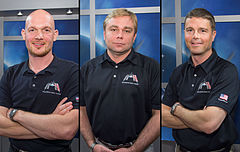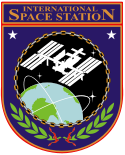Sojuz TMA-13M
| Dane misji | |
| Zaangażowani | |
|---|---|
| Pojazd | |
| Statek kosmiczny | |
| Masa pojazdu | ok. 7200 kg |
| Rakieta nośna | Sojuz-FG |
| Załoga | |
 od lewej: A. Gerst, M. Surajew i G. Wiseman | |
| Dowódca | |
| Start | |
| Miejsce startu | |
| Początek misji | 28 maja 2014, 19:57 UTC |
| Misja na Międzynarodową Stację Kosmiczną | |
| Pobyt na ISS | od 29 maja 2014, 01:44 UTC |
| Lądowanie | |
| Miejsce lądowania | |
| Lądowanie | 10 listopada 2014, 03:58 UTC |
| Program Sojuz | |
Sojuz TMA-13M – misja statku Sojuz do Międzynarodowej Stacji Kosmicznej, której celem było dostarczenie załogi biorącej udział w 40. i 41. ekspedycji i sprowadzenie jej z powrotem.
Start nastąpił 28 maja 2014 z platformy 1/5 kosmodromu Bajkonur, a cumowanie do modułu Rasswiet (MRM 1) Międzynarodowej Stacji Kosmicznej 29 maja.[1] Przycumowana kapsuła odcumowała od stacji z tą samą załogą 10 listopada, a lądowanie nastąpiło tego samego dnia.[2]
Oprócz załogi dostarczono cargo, m.in. użyte do eksperymentów na stacji.
Załoga
Podstawowa
- Maksim Surajew (2) – dowódca (Rosja, Roskosmos)
- Alexander Gerst (1) – inżynier pokładowy (Niemcy, ESA)
- Gregory Wiseman (1) – inżynier pokładowy (USA, NASA)
Rezerwowa
- Anton Szkaplerow (2) – dowódca (Rosja, Roskosmos)
- Samantha Cristoforetti (1) – inżynier pokładowy (Włochy, ESA)
- Terry Virts (2) – inżynier pokładowy (USA, NASA)
Galeria
Przypisy
- ↑ Arrival of Expedition 40 Trio Expands Station Crew to Six (ang.). NASA.gov, 2014-05-28. [dostęp 2015-04-04].
- ↑ Krzysztof Kanawka: Sojuz TMA-13M wrócił na Ziemię (pol.). Kosmonauta.net, 2014-11-10. [dostęp 2015-03-17].
Bibliografia
Media użyte na tej stronie
Expedition 41 Commander Max Suraev of the Russian Federal Space Agency (Roscosmos) is carried in a chair to a medical tent after he and NASA Flight Engineer Reid Wiseman, and Flight Engineer Alexander Gerst of the European Space Agency (ESA) landed in their Soyuz TMA-13M capsule in a remote area near the town of Arkalyk, Kazakhstan on Monday, Nov. 10, 2014. Suraev, Wiseman and Gerst returned to Earth after more than five months onboard the International Space Station where they served as members of the Expedition 40 and 41 crews.
The Soyuz TMA-13M rocket is launched with Expedition 40 Soyuz Commander Maxim Suraev, of the Russian Federal Space Agency, Roscosmos, Flight Engineer Alexander Gerst, of the European Space Agency, ESA, and Flight Engineer Reid Wiseman of NASA, Thursday, May 29, 2014 at the Baikonur Cosmodrome in Kazakhstan. Suraev, Gerst, and Wiseman will spend the next five and a half months aboard the International Space Station.
Expedition 40 Flight Engineer Reid Wiseman of NASA, right, receives the traditional blessing from a Russian Orthodox priest at the Cosmonaut Hotel prior to his launch on the Soyuz rocket to the International Space Station, Wednesday, May 28, 2014, in Baikonur, Kazakhstan. Wiseman, Soyuz Commander Maxim Suraev of the Russian Federal Space Agency, Roscosmos, center, and Flight Engineer Alexander Gerst of the European Space Agency, ESA, left, will spend the next five and a half months living and working aboard the ISS.
Expedition 41 light Engineer Alexander Gerst of the European Space Agency (ESA), left, Commander Max Suraev of the Russian Federal Space Agency (Roscosmos), center, and NASA Flight Engineer Reid Wiseman, sit in chairs outside the Soyuz TMA-13M capsule just minutes after they landed in a remote area near the town of Arkalyk, Kazakhstan on Monday, Nov. 10, 2014. Suraev, Wiseman and Gerst returned to Earth after more than five months onboard the International Space Station where they served as members of the Expedition 40 and 41 crews.
Alexander Gerst, Expedition 40/41 flight engineer representing the European Space Agency, cosmonaut Maxim Suraev, Expedition 40 flight engineer and Expedition 41 commander and astronaut Reid Wiseman of NASA, Expedition 40/41 flight engineer pose for photos following a March 18 press conference at NASA's Johnson Space Center.
One of the Expedition 40 crew members aboard the International Space Station recorded this image showing several states in the USA and a small part of Mexico, including Baja California, on June 23, 2014.
- Parts of Nevada are visible in the bottom of the frame. The area in the Mojave Desert where many space shuttle missions successfully ended is visible near the scene's center. The Gulf of Cortez and several hundred miles of the Pacific coast line of Mexico and California are visible in the top portion of the photo. The heavily populated Los Angeles Basin is just above the Mojave site of shuttle landings, with the San Diego area partially obscured by the docked Russian Soyuz vehicle in the foreground. The Salton Sea is just above left center frame.
European Space Agency astronaut Alexander Gerst, Expedition 40/41 flight engineer, participates in an extravehicular activity (EVA) training session in the Partial Gravity Simulator (POGO) test area in the Space Vehicle Mock-up Facility at NASA's Johnson Space Center.
At the Baikonur Cosmodrome in Kazakhstan, the Expedition 40/41 backup and prime crew members pose for pictures in front of the Soyuz booster rocket's first stage engines May 24 during the final fit check training dress rehearsal. From left to right are backup crew members Terry Virts of NASA, Samantha Cristoforetti of the European Space Agency, Anton Shkaplerov of the Russian Federal Space Agency (Roscosmos), and prime crew members Flight Engineer Alexander Gerst of the European Space Agency, Soyuz Commander Maxim Suraev of Roscosmos and Flight Engineer Reid Wiseman of NASA. Gerst, Suraev and Wiseman will launch May 29, Kazakh time, on the Soyuz TMA-13M spacecraft for a 5 ½ month mission on the International Space Station.
Russian cosmonaut Maxim Suraev (right), Expedition 40 flight engineer and Expedition 41 commander; along with NASA astronaut Reid Wiseman (center) and European Space Agency astronaut Alexander Gerst, both Expedition 40/41 flight engineers, participate in an emergency scenario training session in the Space Vehicle Mock-up Facility at NASA's Johnson Space Center.
Expedition 40 Soyuz Commander Maxim Suraev of the Russian Federal Space Agency, Roscosmos, bottom, Flight Engineer Reid Wiseman of NASA, center, and Flight Engineer Alexander Gerst of the European Space Agency, ESA, top, wave farewell prior to boarding the Soyuz TMA-13M rocket for launch, Wednesday, May 28, 2014 at the Baikonur Cosmodrome in Kazakhstan. Suraev, Gerst, and Wiseman will spend the next six months aboard the International Space Station.
One of the Expedition 41 crew members aboard the International Space Station, flying at an altitude of 220 nautical miles, photographed this night panorama of parts of Europe on Oct. 1, 2014. Kiev, Ukraine is seen near the right edge of the photo in the vertical center. Lights of Constanta, Romania can be seen just below the Russian Progress 56 cargo vehicle docked to the orbital outpost at the top of the frame. The Black Sea is to the left of the Soyuz TMA-13M docked to the station on the left side of the scene. The Sea of Azov is at the right of the bottom portion the Soyuz. Mariupol is near bottom center; and Donetsk, although it appears as a (bottom-most) tiny smudge on the right side of the image, has a population of just under five million. Krasnodar, Russia is in the bottom left corner. Part of Greece is in the top of the image near the solar panel of the Progress, with Thessaloniki and Sofia among the many bright lights. Part of Turkey is in upper left of the land mass visible. Pre-dawn light coming through the atmosphere gives the station hardware a bluish color.























